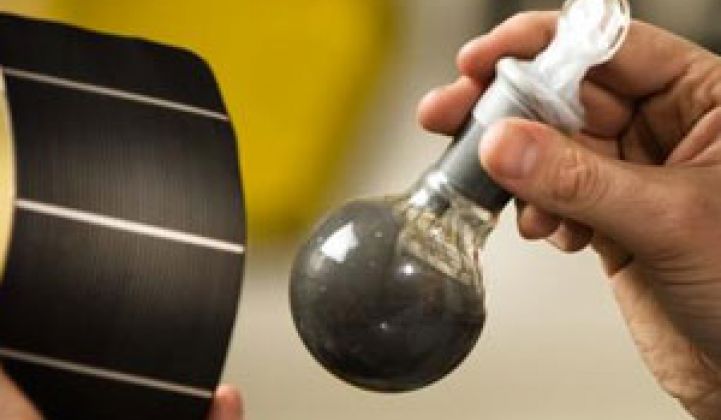CIGS isn't just a new type of thin-film solar cell. It's the biggest melodrama in alternative energy.
And in the next 18 months, the drama will shift into high gear as some companies begin to march down the path of success and others go out in a flaming ball of glory. It will be like a luchadora bout, but inside a manufacturing plant.
Here's the recap: For years, researchers at the National Renewable Energy Labs (NREL) tinkered with trying to produce electricity out of solar cells made from copper, indium, gallium and selenide (CIGS). The idea was that solar cells using these four cheeses would be cheaper than solar cells made with crystalline silicon or cadmium telluride because they could be printed on flexible substrates, rather than glass.
At the same time, CIGS was considered to be more efficient (and more cost-effective) than thin-film silicon solar cells. Unfortunately, two major problems arose. The four elements didn't work well together and producing large numbers of efficient CIGS cells was tough (see New Solar Technology Hits Snags). The folks at NREL worked on this problem for years. The best solution they could find appeared to be evaporation, a somewhat time-consuming process.
Nonetheless, fears about energy security and electricity costs prompted many in the early part of the decade to get into CIGS. Each had its own manufacturing concept and methods: printing (Nanosolar), chemical sputtering (Miasolé), electroplating (Solopower) a sputtering/patterning-like thing called FASST (HelioVolt) and still evaporation (Global Solar). In some cases, companies were even making their own machinery.
Millions flowed in. By 2007, five companies – Nanosolar, Miasolé, Solopower, HelioVolt and Solyndra – collectively raised $344 million. But, oops, problems still existed. Miasolé, which earlier predicted $100 million in revenue by the end of 2007, delayed its initial products to 2009 and admited efficiency wasn't as good as it should be. HelioVolt and DayStar Technologies delayed their releases too.
Still, the rush was on and everyone added employees. Secretive Solyndra, which refused to talk about its technology and had no revenue, went on a hiring spree that lead to more than 400 employees. Solopower got Rommel Noufi, one of the NREL researchers, to join.
By the end of 2007, only two companies – Nanosolar and Global – got their products out the door. Global documented its efficiency over 10 percent (see Nanosolar Begins Production and Heliovolt on Nanosolar's Heels).
As 2008 began, though, reports circulated that the silicon shortage would end in 2009, slimming at least the near-term prospects for CIGS. But what happened? Nanosolar landed $300 million more, while Solyndra and Miasolé sought out $350 million and $200 million, respectively.
So what happens next?
1. Success for Some: Global Solar and one or two others will begin to sell panels in appreciable amounts. Progress on integrating CIGS into building materials will occur fast enough to stop some worries.
2. But Delays for Others: The ornate manufacturing processes for some companies will take time to wrinkle out. With millions already invested, investors will clamor for some kind of progress or a merger. The delays will take on the air of doom.
3. Failed Attempts at Mergers and Acquisitions: Or at least this is what nearly every VC tells me they think will happen. How attractive is a company with an iffy manufacturing plan and customers committed only if they can get to volume? Plus, think of the price. Some have said that Nanosolar or Solyndra would have to come out of an IPO with close to a $20 billion valuation to placate investors. Some of these companies will be way to expensive too buy.
4. The First Solar Analogy Falters: Much of the investment in CIGS revolves around the comparison to cad tel maker First Solar. It's valued at $22 billion. CIGS, which has advantages over cad tel, should do better. But First Solar tinkered with its technology for 20 years and has an uncanny brilliance when it comes to executing a business strategy. Today's CIGS companies don't have the luxury of low expectations and probably don't have that mystical touch when it comes to meeting quarterly results – few companies in any industries do.
5. A Strategic Transformation Into an Equipment Maker: The weird part about CIGS is that the panels that will come from these manufacturers will largely act and do the same thing. What makes them proprietary is their process. They are, in short, really equipment companies trapped in the body of product suppliers. They are far more like Applied Materials than Intel. Those that fall behind in panels – but aren't deluded by solar glory – will follow this less-glamorous route.
6. Enter Applied Materials: These guys love equipment. If you're a failing CIGS company, expect a call from Mike Splinter, if your price is reasonable.
7. III-V Becomes the New Fad: As many CIGS companies head to the tar pits, investors forget the past and start looking at the bright future of companies making panels with elements from the III-V section of the Periodic Table with concentrators. It works for spacecrafts, after all.



